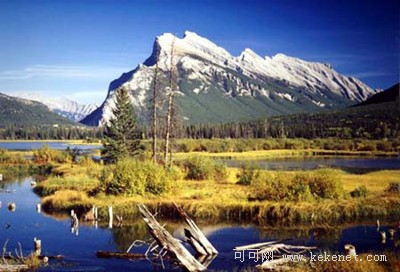我们上一次的收获是16亿年前的叶子化石,那么发现了它意味着什么呢?低温度下的叶子与温暖环境中的叶子相比,它们的叶缘上面会有什么样的变化呢?这是值得探讨的。接着听哦!

Leaves with teeth do better in colder climates because teeth are actually really advantageous in jump-starting growth at the beginning of the growing seasons. In this case, you can see this beautiful fossil leaf here with teeth, and each of the teeth are a little hotbeds of photosynthesis(光合作用), so when that leaf first comes out of the bud, it gets a jump-start on leaves that don't have teeth.
Miller uses this information to find out about the height of the young Rocky Mountains. In a simple but powerful technique, he compares the number of leaves with teeth to those without.
You go to a particular area, and you pick up all the species of leaves that are there from the trees that are growing in that area, and you compare the number of species that have teeth to the number of species that have smooth margins. That gives us some idea of what the temperature is.
So the higher the proportion of plants with jagged edges compared to plants with smooth edges, the colder the temperature of the site. And the colder the temperature, the higher the mountain.
So if you've got into a hot air balloon here today, and you float it straight up into the atmosphere, the temperature will decrease in a very predictable way, and it turns out that for about every mile you go up in the atmosphere, you lose about 20 degrees Fahrenheit. So if we know how temperature changes with elevation, we can back out elevation from those estimates of temperature.
To work out the height of the early mountain, Miller needs to compare samples from two areas, one at the base of the mountain and one at the top. Fossils found at the base of the Rockies near the present-day Denver have an amazing story to tell. These ancient leaves are incredibly similar to plants growing in the tropics today.
So after the Rockies rose, down in the area of Denver, it was sub-tropical and tropical forests, we have palms, and cycads, and canopies like we see in the tropics today. Up here we had a forest that looked probably more like a forest that grows in North or South Carolina on the east coast of the U.S.
By comparing the ancient fossil leaves from the top of the mountain with fossil leaves from the foot of the mountain, Miller has come up with a surprising conclusion.
It turns out that the fossil leaves here are predominantly toothed as compared to those that are in Denver which are predominantly smooth margin. And it turns out the ones in Denver grew in a climate that was about, on average about 75 degrees Fahrenheit, the ones up here grew in a climate that was probably about 50 degrees Fahrenheit. So if we know how temperature changes with elevation, that means that this site, when these fossil leaves were deposited, was about a mile higher than Denver. Today it's only a half mile higher. So 60 million years ago, the mountains would be twice as high as they are today.
小编有约:本期的文章中有许多对比的句子,非常的地道。可以摘抄下来,试着自己写作文的时候用。不仅仅是优美的文章,同时Daisy也认为它告诉了我们探索真理的一种方法。这种方法叫“比较研究法”,通过对近缘物种的行为进行对比分析,以了解行为适应和进化的重要方法。这是一种科学的研究方法。在学习物理和化生时,会用到这个方法。
课后题目:Daisy提供这三个线索,你来找找看这个答案。A. You've got into a hot air balloon. B.You float it straight up into the atmosphere. C. The temperature will decrease in a very predictable way.











